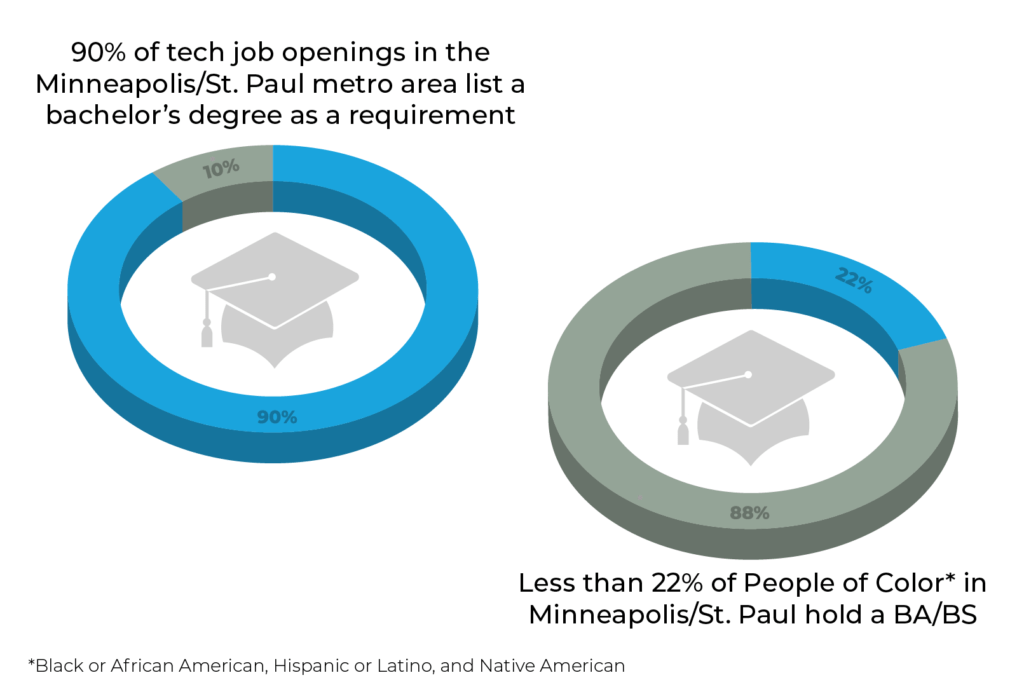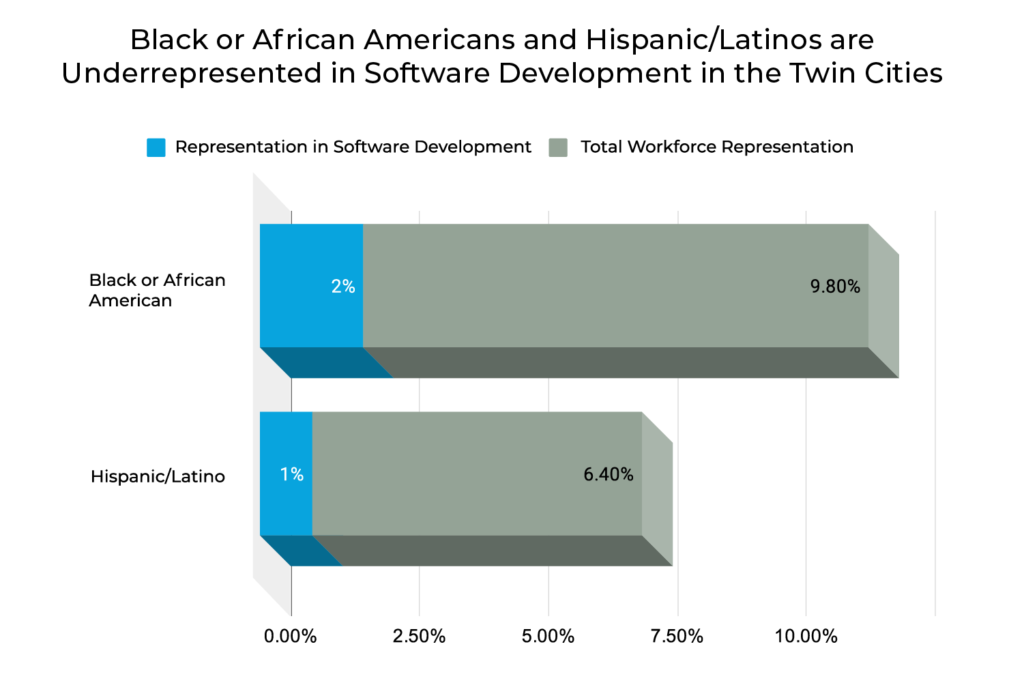By: Katie McClelland, Director of Policy & Research, Minnesota Technology Association
Much like the rest of the country, Minnesota companies are struggling to find talent. In fact, there are currently nearly two and a half jobs for every job seeker in the state.1 The tech sector is no exception, with over 26,000 positions posted on average every month and an expected 4% projected growth rate over the next 5 years.
Despite the median salary for tech occupation jobs in Minnesota being $92,175, Minnesota employers are still struggling to find people to fill these open roles. Part of this problem is self-imposed, as 90% of tech job postings for the MSP Metro have a bachelor’s degree as a requirement,2 putting Minnesota solidly behind national averages for degree requirements in the tech space.

As an example, software developers and software quality assurance analysts and testers are the most in-demand tech roles in Minnesota, with over 7,000 positions posted monthly yet only 1,000 hires per month on average.3 Like many other sectors, diversity remains a challenge within the tech sector.
When looking at the diversity within software developers, just 1% of software developers in the MSP region are Hispanic or Latino as compared to the 6.4% of the MSP workforce overall, while only 2% are Black or African American, as compared to 9.8% of the total MSP workforce.4
We will not close the gap in open positions without major changes in hiring requirements given that less than 22% of Black, Indigenous, and Hispanic/Latino individuals, respectively, in the MSP Metro hold a BA/BS, and the percentage becomes even smaller when looking at IT related BA/BS degrees. It’s especially noteworthy that only 60% of companies nationally require a bachelor’s degree for software developer roles, demonstrating that Minnesota companies must make changes in order to compete for talent nationally.5

What’s more, we do not have a strong talent pipeline into tech-related roles in Minnesota, as we currently rank last in the nation for high schools offering computer science.6 If students don’t have access to these courses at the high school level, they will be less likely to take similar courses in college, which is demonstrated by just under 4,000 students completing Computer and Information Sciences and Support Services programs at the postsecondary level in 2020.7
The good news is that there are clear solutions to this tech talent challenge that cities and states across the country are already implementing, ones that could easily be replicated and improved upon in Minnesota starting now.
Employer Solutions
One of the more important challenges we face in the tech sector is diversifying our talent pipelines, and a group of Chief Information Officers and Chief Technology Officers from companies across the Twin Cities have made commitments to do just that. The Tech Inclusion Alliance (TIA), first convened by Target and now joined by U.S. Bank, Thomson Reuters, CH Robinson, Winnebago, Ecolab, United Health Group and other leading tech employers, is committed to working together to close the tech talent gap while simultaneously addressing racial and economic disparities.
This work includes supporting expanded computer science pathways at the K-12 level, leveraging non-traditional pathways at the postsecondary level through bootcamps and apprenticeship programs, and supporting public policies that help a diverse community of workers address barriers to entering the tech workforce. These employers are supporting new career pathways into their companies, and this year MnTech will be working with local education and training providers to ensure that the curriculum matches employer’s needs.
Public Policy
Education and workforce development policies and programs that expand talent pipelines to include more diverse representation of Black, Indigenous, and People of Color (BIPOC) communities and women are critical to the success of the tech sector in Minnesota. This is why MnTech supports the additional funding called for by the Governor to prepare more youth for tech careers and equip unemployed and under-employed adults with the digital skills needed to succeed in an increasingly tech-driven economy. This includes the Governor’s proposed $15 million investment in the Tech Youth Training program and $13 million investment in the Adult Tech Training Program for Black, Indigenous, People of Color (BIPOC), and women. We also support robust investments in the creation and expansion of new information technology apprenticeship programs.
Education and workforce development policies and programs that expand talent pipelines to include more diverse representation of Black, Indigenous, and People of Color (BIPOC) communities and women are critical to the success of the tech sector in Minnesota.
Over the last decade, states across the nation have taken intentional steps and increased investments in expanding access to computer science education by creating plans for K-12 computer science education, establishing clear computer science standards, supporting teachers through professional development and certification, and ensuring that all high school students can access courses. Minnesota has fallen well behind, particularly with our peer states in the Midwest region.
A first step in addressing Minnesota’s failure to compete is passing the legislation proposed by Representative Davnie and Senator Koran establishing a computer science education foundational blueprint for the state (HF 3243/SF 3578). Setting a plan for how to ensure all Minnesota students can access computer science education is critical, as is taking steps to ensure there is sufficient financial support for teacher professional development so that Minnesota has the workforce to support an expansion in computer science education.
The need for skilled talent in the tech sector will only intensify, which is why addressing this issue is such a strategic imperative for MnTech and the companies and communities we serve. Working together, we can build the skilled, and more inclusive, tech workforce needed to sustain the strength and vibrancy of our tech ecosystem and Minnesota’s innovation economy for decades to come.
- “Minnesota has twice as many job openings as job seekers,” https://www.bizjournals.com/twincities/news/2022/04/25/minnesota-job-openings-rate-feb-2022.html
- Chmura JobsEQ 2021Q2 analysis of BLS IT Cluster education data by employment, and typical education and training requirements by occupation based on BLS. Job Posting Data from Gartner TalentNeuron Recruit for 2021 postings.
- Quarterly MnTech eImpact Report; Emsi
- Quarterly MnTech eImpact Report; Emsit, Minnesota Department of Employment and Economic Development, U.S Census Bureau, 2015-2019 American Community Survey
- The Emerging Degree Reset, https://static1.squarespace.com/static/6197797102be715f55c0e0a1/t/6202bda7f1ceee7b0e9b7e2f/1644346798760/The+Emerging+Degree+Reset+%2822.02%29Final.pdf
- 2021 State of Computer Science Education, https://advocacy.code.org/state_handouts/Minnesota.pdf
- Quarterly MnTech eImpact Report; Emsi

























